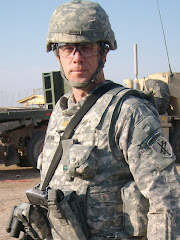This took place a week and a half ago but I’ve been too busy to write.
All of our training at Ft. Dix, NJ is being conducted by a group of Army Reservists who’s primary responsibility is to train and prepare Soldiers in all of their individual and collective tasks. They are Drill Sergeants and they have provided some of the best training in my military career. The schedule they provided us is pretty packed but there are specific blocks of time set aside for rest and reconstitution. For example, after being on a night qualification range the next morning is set aside as “commander’s time” from 0800 to 1200. In other words, this is time for me to judiciously allow my Soldiers to clean their clothes, weapons, or catch up on other personal business.
Into this commander’s time, my time, a group from the Civil Affairs Training Brigade (CAPOCTB), stationed Ft. Bragg, NC, stepped in to insist on additional training that the deploying Civil Affairs Soldiers need. They are not Drill Sergeants, and training Soldiers is not their primary military profession.
The CAPOCTB decided to conduct a weapons range at Range 29B that would consist of advanced pistol marksmanship and transition fire. Advanced pistol marksmanship consists of drawing a loaded weapon from a holster, firing at a target, and then re-holstering the weapon after it is put on “safe”. Transition fire consists of shooting several rounds from your primary weapon (a rifle) and then putting that weapon on “safe” and using a secondary weapon (a pistol). Both have a higher that usual amount of risk and therefore require significant training, practice, and safeguards to execute properly.
We arrived at the range at 1500, an hour before training was supposed to start. From the beginning I sensed trouble. All of the instructors were sitting in the shade. No targets were up. The ammunition was still crated. The range was not properly opened.
As we got off the bus the instructors walked away and no one welcomed us or gave us further instructions. We asked for the Officer in Charge (OIC) and no one budged. The Range Safety Officer (RSO) rather matter of factly told us that the range would be open and ready on time. Then he told us that they were only expecting 32 people instead of 60. Then he told us that they didn’t know where the person was to put the range into operation. In other words the gnawing feeling in my gut wasn’t getting better.
Someone finally came to us around 1540 and gave us the welcome briefing. He pointed out that range wasn’t ready yet and that we should drink water and stay out of the heat in the meantime. I asked the obvious question that I was afraid I already knew the answer to, “where is the water point?” The blank look in response told me what I needed to know. All that they had was a five gallon cooler of Gatorade for 60 plus people. Safety violation number one. My ire rose and demanded to see the OIC.
The commander and a senior NCO came over. As it turned out, these two were the instructors bosses who had just arrived to Ft Dix observe the training. I blasted them expecting that my unpleasant disposition on the situation would rub off on them and that they in turn would take corrective action on their people. I expected too much.
As the instruction started, the primary trainer handed out pistols to the Soldiers without making them go through the proper clearing procedures. Then he stood between the Soldiers and the targets and had the Soldiers dry fire. Of course the weapons were empty. Of course we all knew that in theory. However, that’s also the way people get shot. Safety violation number two.
What happened next was a series of trivial to minor safety and procedural issues that compounded on top of one another. There was no dry run or walk through; Soldiers got the class and then drew ammunition. The class that was given was not what was executed on the range. The person giving the commands from the tower didn’t know the proper sequence of events. Inexperienced firers were put on the firing line with too few safety observers. The inexperienced firers were pushed to shoot at a pace faster than they ever had before. People became confused. The firers were expected to fire and move forward at the same time. Finally, the firers stood at point blank range from the target and fired over 40 rounds into hit. Rounds went everywhere. Strike three.
I talked to my friend Dennis, the other company commander. He saw everything that I saw and he felt the same way I did. Together we called for a pause, located the range company commander, and told him, “We’re done.” We told them that the range was unsafe and that someone was going to get hurt. I pulled my guys off of the range, had them clean up, and put them on the busses for the barracks. We walked off the range and left the CAPOCTB personnel looking at us in contemptuous disbelief.
In my time in the Army I have never heard of an incident like this ever happening. I have heard many war stories, and stories that always begin, “There was this one time where…” but this one for the Soldiers who witnessed it to take with them and tell over and over for a long time to come.
What happened on Range 29B never materialized into a tragedy although it had all of the markings for it. In retrospect, I probably never should have let my Soldiers even get on the firing line with ammo and trusted what appeared to be a bunch of bozos with their safety. In other words, I should have listened more carefully to that voice in the back of my head. That voice is usually right.






